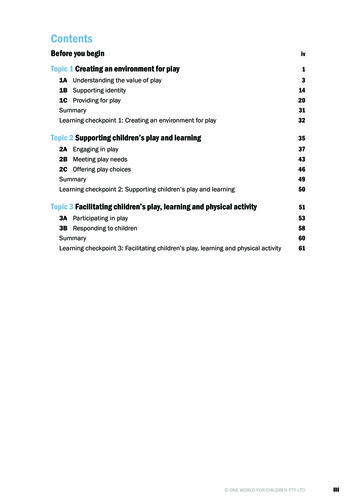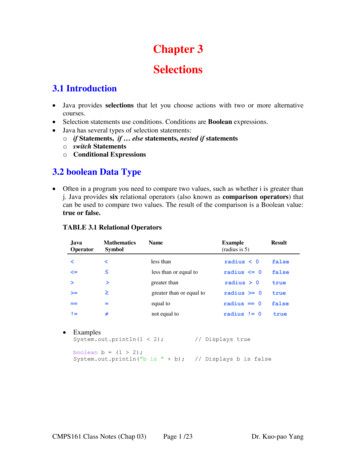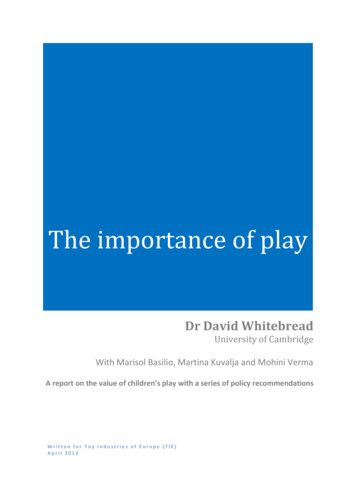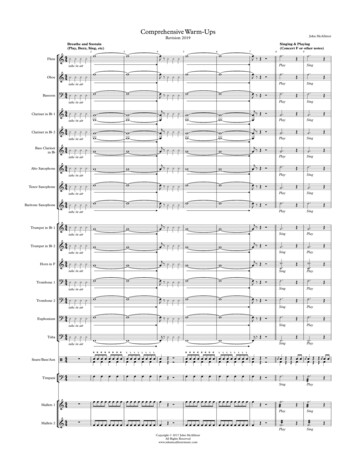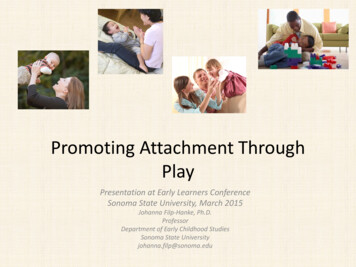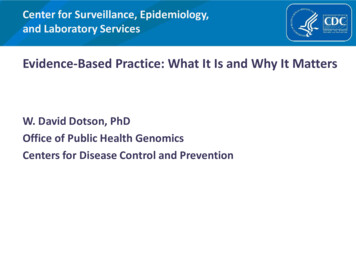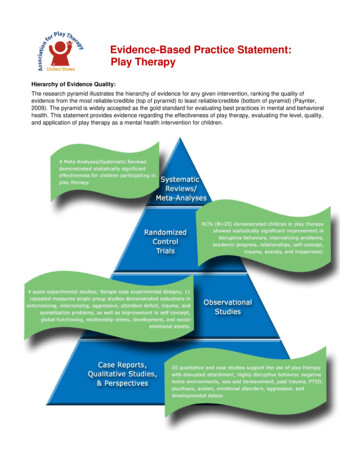
Transcription
Evidence-Based Practice Statement:Play TherapyHierarchy of Evidence Quality:The research pyramid illustrates the hierarchy of evidence for any given intervention, ranking the quality ofevidence from the most reliable/credible (top of pyramid) to least reliable/credible (bottom of pyramid) (Paynter,2009). The pyramid is widely accepted as the gold standard for evaluating best practices in mental and behavioralhealth. This statement provides evidence regarding the effectiveness of play therapy, evaluating the level, quality,and application of play therapy as a mental health intervention for children.
DefinitionsPlay Therapy: Play therapy is the systematic use of a theoretical model to establish an interpersonal process whereintrained play therapists use the therapeutic powers of play to help clients prevent or resolve psychosocial difficulties andachieve optimal growth and development (APT, 2015).Systematic Reviews/Meta-Analyses: Systematic reviews provide a structured method of critically appraising findings frommultiple studies involving a particular area of study or intervention. Meta-analyses statistically evaluate and integrate thefindings of multiple studies involving a particular are of study or intervention. When applied to intervention research, thegoal of both systematic reviews and meta-analyses is to formulate a recommendation for practice.Randomized Controlled Trials (RCTs): RCTs are experimental research studies that employ comparison groups andrandomized assignment of participants. The goal of RCTs is to provide exploration of an intervention and methodologicalcontrol over variables so that outcome and treatment effect can be generalized to an identified population.Observational Studies: Observational studies include quasi-experimental studies (research that does not employrandomization procedures), single-case experimental designs, correlational research (research that explores associationsbetween variables), and pre-post single group studies. Observational studies employ quantitative analyses but are limitedin their controls of variables; hence, they are limited in terms of generalizing causal relationships between variables.Case Reports: Case reports, also referred to as case studies, are reports on individual cases that provide anecdotalevidence, and can include individual quantitative data, on the use of a particular intervention.Qualitative Studies: Qualitative research uses qualitative methods and analyses to provide rich description, perspectives,theoretical understanding, and experiences related to the use of a particular intervention.Search InformationDatabases: PsycINFO, PubMed, ERIC, Academic Search CompleteSearch Terms: play therapy, play counseling, play interventionLimits, Filters, Search Data Parameters: 2000 to present; primarily individual interventionDate Most Recent Search: June 1, 2016Identified PopulationChildren from 3 to 13 years old.RecommendationsChildren between the ages of 3 to 12 years old should participate in play therapy as an intervention to alleviate symptomsrelated to behavioral and emotional problems, as well as contribute to overall wellness and healthy development.Association for Play Therapy, Inc., 401 Clovis Ave., #107, Clovis, CA 93612 USA, (559) 298-3400, Fax (559) 298-3410, a4pt.orgPage 2 of 20
Evidence Related to RecommendationsSystematic Reviews and Meta-AnalysesTo date, there are 4 peer-reviewed published meta-analyses on outcome effect of play therapy interventions; one meta-analysisincludes a systematic review. Lin and Bratton (2015) conducted meta-analysis with 24 child-centered play therapy studies andconcluded that play therapy demonstrated a statistically significant effect. Ray, Armstrong, Balkin, and Jayne (2015) performeda meta-analysis and systematic review of 23 child-centered play therapy RCTs conducted in schools and concluded that playtherapy demonstrated statistically significant outcomes for children with disruptive behavior, internalizing, self-efficacy, andacademic problems. Bratton, Ray, Rhine, and Jones (2005) employed meta-analysis with 67 play therapy studies and foundstatistically significant effects with medium effect size, concluding that play therapy was effective with both internalizing andexternalizing problems. LeBlanc and Ritchie (2001) used meta-analysis to explore findings of 42 RCTs on play therapy,reporting statistically significant effects with moderate treatment effect size.AuthorsLin & Bratton (2015)# ofStudiesMean AgeEffect SizeFavorable OutcomesExternalizing and internalizing behaviorproblems; caregiver-child relationship stress;self-efficacy246.7 yrs.33*Ray et al. (2015)23Range4-13 yrsNo MeanReported.21-.38*Bratton et al. (2005)677.0 yrs.72*Behavior problems; social adjustment;self-concept; anxiety; development;relationships; otherLeBlanc & Ritchie (2001)427.8 yrs.66* Emotional adjustment; social adjustment;reaction to traumatic event; academic;behavior problems; family adjustmentExternalizing and internalizing behaviorproblems; self-efficacy; academic; other*ES is statistically significant Studies included parent-involvemRandomized Controlled Trials (RCTs)Randomized controlled trials (N 25) demonstrated children in play therapy showed statistically significant improvement indisruptive behaviors, internalizing problems, academic progress, relationships, self-concept, trauma, anxiety, and impairment.Play therapy RCTs serve as credible evidence that play therapy is effective across ages 3 to 12 years old and with variouspresenting issues. All reviewed RCTs employed the use of random assignment, control or comparison experimental groups,clear intervention protocol, and appropriate data analysis procedures.Disruptive Behaviors:Several studies found statistically significant decreases in disruptive behavior for children in child-centered play therapy (CCPT)over children in a control group (Bratton et al., 2013; Garza & Bratton, 2005). Adlerian play therapy has also been found to beeffective in reducing disruptive behaviors (Meany-Walen, Bratton, & Kottman, 2014). Fall, Navelski, and Welch (2002)demonstrated decreased problematic behaviors and decreased social problems for a CCPT experimental group whencompared to the control group. Naderi, Heidarie, Bouron, and Asgari (2010) showed that children in activity-based play therapyshowed statistically significant decreases in ADHD and anxiety symptomology when compared to a control group, whilePackman and Bratton (2003) found that children showed decreases in externalizing behaviors after receiving humanisticallybased group activity/play therapy. Furthermore, Ojiambo and Bratton (2014) found that displaced Ugandan orphans whoparticipated in group activity play therapy demonstrated significant decreases in problem behaviors.Internalizing Problems:Farahzadi, Bahramabadi, and Mohammadifar (2011) described clinically significant decreases in diagnostic severity of socialphobia symptoms following Gestalt play therapy. Flahive and Ray (2007) found that children in sandtray/play therapy groupdemonstrated clinically significant differences in internalizing and externalizing behaviors when compared to a control group.Garza and Bratton (2005) showed that children receiving CCPT showed moderate improvements in internalizing behaviors.Jalali and Molavi (2011) found that children in group play therapy showed statistically significant decreases in separationanxiety when compared to a control group. Naderi et al. (2010) showed that children in activity-based play therapy showedimprovement in social maturity when compared to a control group. Packman and Bratton (2003) found that children showeddecreases in internalizing behaviors after receiving Humanistically-based activity group therapy. Ray, Schottelkorb, and TsaiAssociation for Play Therapy, Inc., 401 Clovis Ave., #107, Clovis, CA 93612 USA, (559) 298-3400, Fax (559) 298-3410, a4pt.orgPage 3 of 20
(2007) found that children with attention problems benefitted with improved emotional stability and anxiety/withdrawn symptomsafter participating in CCPT. Stulmaker and Ray (2015) found that young children who scored clinically anxious improvedsignificantly following participation in individual CCPT.Academic and Language Concerns:Blanco and Ray (2011) found that children in a CCPT experimental group showed significant improvement on academicachievement over children in a control group. Additionally, Danger and Landreth (2005) demonstrated clinical significantimprovements in language skills in children who received CCPT over children in a control group.Relationships:Both Ray (2007) and Ray, Henson, Schottelkorb, Brown, and Muro (2008) found that CCPT resulted in significant decreases inteacher child relationship stress. Ray et al. (2008) found that short-term CCPT intervention (16 sessions over 8 weeks)demonstrated statistical significance and larger effect sizes in total stress, teacher, and student characteristics than long-termCCPT intervention (16 sessions over 16 weeks). Cheng and Tsai (2014) showed that participation in CCPT group wasassociated with fewer socially withdrawn behaviors. Finally, Cheng and Ray (2016) found that children who participated ingroup CCPT demonstrated gains in social-emotional assets, specifically empathy and social competence.Trauma:Schottelkorb, Doumas, and Garcia (2012) found that both CCPT and trauma-focused cognitive behavioral therapy (TF-CBT)were effective in reducing trauma symptoms according to child and parent report. Shen (2002) also demonstrated the use ofCCPT for children following an earthquake. The author showed that a CCPT group demonstrated a significant decrease inanxiety and suicide risk when compared to the control group. In examining CCPT with children of domestic violence, TyndallLind, Landreth, and Giordano (2001) demonstrated that participation in sibling group play therapy was associated withsignificant reductions in total behavior, externalizing, and internalizing behavior problems, aggression, anxiety, depression andsignificant improvements in self-esteem. The authors found that sibling group play therapy was equally effective to intensiveindividual play therapy.Impairment and Medical Concerns:Ray, Stulmaker, Lee, and Silverman (2013) found that a CCPT group demonstrated decreased levels of impairment withmedium effect size compared to a delayed-start control group. Jones and Landreth (2002) showed that children in CCPT wereable to adapt to diabetes better than a control group.RCT Study DescriptionsAuthorsCheng & Ray(2016)Su & Tsai (2016)Type, #, &Session LengthGroup CCPTR 15-1630 minutesGroup CCPT1240 minutesSample DescriptionKindergartners identified withsocial-emotional deficitsN 43Ages 5-623% African American44% Hispanic/Latin33% CaucasianChildren of new immigrants inTaiwan with relationshipproblemsN 8Ages 8-938% Vietnamese38% Thai25% ChineseFindingsChildren who received group CCPTdemonstrated statistically significantimprovement in overall social-emotional assets,empathy, and social competence over controlgroup children according to parent report.Children who participated in CCPT improved inrelationships according to self and teacher reportover those in the control group. CCPT childrenalso demonstrated significant improvement inmood as reported by parents. Authors employed non-parametric analyses dueto low participant numberAssociation for Play Therapy, Inc., 401 Clovis Ave., #107, Clovis, CA 93612 USA, (559) 298-3400, Fax (559) 298-3410, a4pt.orgPage 4 of 20
Blanco, Muro,Holliman,Stickley, & Carter(2015)Stulmaker & Ray(2015)Cheng & Tsai(2014)*Individual CCPT1630 minutesIndividual CCPTR 12-1630 minutesIndividual CCPT10First gradersN 59Ages 6-76% African American17% Hispanic/Latin69% Caucasian2% Asian AmericanChildren who scored inclinically anxious rangeN 53Ages 6-821% African American21% Hispanic/Latin45% Caucasian2% Asian11% BiracialChildren identified as sociallywithdrawnN 7Ages 9-10100% TaiwaneseMeany-Walen,Bratton, &Kottman (2014)Ojiambo &Bratton (2014)Individual AdlerianPTR 14-1730 minutesGroup activity PTM 1650 minutesChildren with disruptivebehaviorsN 58Ages 5-919% African American48% Hispanic/Latin33% CaucasianDisplaced orphans in Ugandawith behavioral problemsN 60Ages 10-12Children who participated in CCPT demonstratedstatistically significant improvement on academicachievement as compared to children in thecontrol group. All children demonstratedstatistically significant improvement onperformance anxiety.Children who received CCPT significantlydecreased their overall levels of anxiety andworry when compared to an active control group.Children in the CCPT treatment groupdemonstrated statistically significant decrease insocial withdrawal but no significant change inself-concept. Authors employed non-parametric analyses dueto low participant numberChildren in therapy demonstrated statisticallysignificant decreases in disruptive behaviorproblems as compared to children in activecontrol group. Teachers also reported astatistically significant reduction in teacher-childrelationship stress for children in theexperimental group.Results demonstrated statistically significantdecreases in behavioral problems with moderateto large effect sizes over children in activecontrol group.100% AfricanRay, Stulmaker,Lee & Silverman(2013)Individual CCPTR 12-16 sessions30 minutesChildren with clinicalimpairmentN 37Ages 5-832% African American38% Hispanic/Latin30% CaucasianCCPT group demonstrated decreased levels ofimpairment with medium effect size whereaschildren in the delayed-start control group hadconsistent or increased levels of impairment.Association for Play Therapy, Inc., 401 Clovis Ave., #107, Clovis, CA 93612 USA, (559) 298-3400, Fax (559) 298-3410, a4pt.orgPage 5 of 20
ko, &Jones (2013)Schottelkorb,Doumas, &Garcia (2012)Individual CCPTR 17-2130 minutes42% African American39% Hispanic/Latin18% CaucasianIndividual CCPTM 1730 minutesBlanco & Ray(2011)Individual CCPT1630 minutesFarahzadi,Bahramabadi, &Mohammadifar(2011)*Gestalt PT1090 minutesJalali & Molavi(2011)*Children with disruptivebehaviorsN 543-4 years oldRefugee children with traumasymptomologyN 26Ages 6-1368% African American16% Middle Eastern10% Asian6% OtherAcademically at-riskN 431st grade17% African American34% Hispanic/Latin46% CaucasianChildren with social phobiaN 124th gradeChildren in CCPT demonstrated statisticallysignificant decreases in disruptive behaviors overchildren in active control group.Results indicated that both CCPT and TF-CBTwere effective in reducing trauma symptomsaccording to child and parent report.Children in the CCPT treatment groupdemonstrated significantly significantimprovement on academic achievementcomposite score over children in delayed-startcontrol group.Children in play therapy decreased scores of thediagnosing and severity factors of social phobiasymptoms.100% from TehranGroup PT6Children with separationanxietyN 30Ages 5-11Authors found that children who participated ingroup play therapy demonstrated statisticallysignificant reduction in separation anxiety ascompared to no-treatment control group.100% from IsfahanNaderi, Heidarie,Bouron, & Asgari(2010)Activity-based PT101 hourChildren diagnosed with ADHDand anxietyN 80Ages 8-12100% IranianRay, Henson,Schottelkorb,Brown, & Muro(2008)Individual CCPT1630 minutesChildren with emotional andbehavioral difficultiesN 58Pre-K-5th grade7% African American41% Hispanic/Latin45% Caucasian7% BiracialChildren in therapy demonstrated statisticallysignificant decreases in symptoms of ADHD andanxiety as compared to no-treatment controlgroup. Children in therapy demonstratedstatistically significant improvement in socialmaturity as compared to control group.Results indicated that both intervention groups(short and long-term play therapy) demonstratedsignificant improvement in teacher-studentrelationship stress. Post hoc analyses indicatedthat the short-term intensive interventiondemonstrated statistical significance and largereffect sizes in overall total stress, teacher andstudent characteristics.Association for Play Therapy, Inc., 401 Clovis Ave., #107, Clovis, CA 93612 USA, (559) 298-3400, Fax (559) 298-3410, a4pt.orgPage 6 of 20
Ray (2007)Ray,Schottelkorb &Tsai (2007)Individual CCPT1630 minutesIndividual CCPT1630 minutesChildren with emotional andbehavioral difficultiesN 93Ages 4-1113% African American41% Hispanic/Latin42% Caucasian4% BiracialChildren with Attention DeficitHyperactivity (ADHD)symptomsN 60Ages 5-1117% African American38% Hispanic/Latin45% CaucasianFlahive & Ray(2007)Danger &Landreth (2005)Garza & Bratton(2005)GroupSandtray/PlayTherapy1045 minutesGroup CCPT2530 minutesIndividual CCPT1530 minutesChildren with behavioraldifficultiesN 56Ages 9-129% African American62% Hispanic/Latin28% CaucasianChildren who qualified forspeech therapyN 21Ages 4-619% Hispanic/Latin81% CaucasianChildren demonstratingbehavioral problemsN 29Ages 5-11100% Hispanic/LatinPackman &Bratton (2003)Humanisticallybased activitygroup/play therapy1260 minutesChildren with learningdisabilities and behavioralproblemsN 244th & 5th gradeResults demonstrated significant decreases inteacher child relationship stress with large effectssizes in total stress for all three treatment groups(play therapy, teacher consultation and playtherapy, and teacher consultation only).Results indicated that both conditionsdemonstrated statistically significantimprovement on ADHD, student characteristics,anxiety, and learning disability. Children in CCPTdemonstrated statistically significantimprovement over active control children onstudent characteristics, emotional stability andanxiety/withdrawn.Children in sandtray/play therapy groupdemonstrated statistically significant differencesas rated by teachers in total, externalizing, andinternalizing behaviors when compared todelayed-start control group. Parents ratedsandtray/play participants significantly differenton externalizing behaviors.Results revealed that children in CCPTdemonstrated increased receptive languageskills and expressive language skills with largepractical significance over children in the notreatment control condition.Compared to comparison group (evidence-basedschool intervention), children receiving CCPTshowed statistically significant decreases inexternalizing behavior problems and moderateimprovements in internalizing behavior problemsas reported by parents.Children in therapy demonstrated decreases inexternalizing and internalizing problems withlarge effect sizes over the no-treatment controlgroup.4% African American4% Hispanic/Latin92% CaucasianAssociation for Play Therapy, Inc., 401 Clovis Ave., #107, Clovis, CA 93612 USA, (559) 298-3400, Fax (559) 298-3410, a4pt.orgPage 7 of 20
Fall, Navelski &Welch (2002)Individual CCPT630 minutesChildren identified for specialeducationN 66Ages 6-1098% Caucasian2% UnidentifiedJones &Landreth (2002)Individual CCPT1230 minutesChildren with diabetesN 30Ages 7-113% African American7% Hispanic/Latin87% CaucasianShen (2002)Group CCPT1040 minutesChildren at high-risk formaladjustment following anearthquakeN 30Ages 8-12Results demonstrated no difference between thegroups in self-efficacy but teacher ratingsshowed decreased problematic behavior andless social problems for the experimental groupas compared to the no-treatment control group.Both groups improved anxiety scores; theexperimental group showed a statisticallysignificant increase in diabetes adaptation overthe no-treatment control group.CCPT group demonstrated a significantdecrease in anxiety, as well as a large treatmenteffect, and significant decrease in suicide risk ascompared to the no-treatment control group.100% TaiwaneseTyndall-Lind,Landreth &Giordano (2001)Individual & groupCCPT1245 minutesChildren living in domesticviolence shelterN 32Ages 4-1039% African American21% Hispanic/Latin40% CaucasianChildren in sibling group play therapydemonstrated a significant reduction in totalbehavior, externalizing, and internalizingbehavior problems, aggression, anxiety,depression and significant improvement in selfesteem. Results indicated that sibling group playtherapy was equally effective to intensiveindividual play therapy.R Range of number of sessions; M Mean number of sessions; N Total number of children in study; CCPT Child centeredplay therapy; TF-CBT Trauma-focused cognitive behavioral therapy*Details limited due to study published in language other than English. Information taken from abstract.Observational StudiesObservational studies (N 25) provide credible evidence that play therapy is effective when exploring its application with singlecase experimental designs (6 single case studies using baseline measures for control and data analyses), quasi-experimentalstudies (3 studies using comparison or control groups, measurement, and data analysis but do not use random assignment),and cohort groups measured over time (10 repeated measures single group studies).Single-Case Experimental Designs:Rigorous single case experimental designs (SCED) in which researchers utilized baseline control phases, multiple datacollection points, intervention protocols, and current data analysis methods provide evidence that play therapy interventionprovides substantial and effective treatment to children who are not demonstrating improvement prior to treatment.Schottelkorb and Ray (2009) demonstrated positive effect of play therapy on children demonstrating clinical levels of ADHDsymptoms. Swan and Ray (2014) found that CCPT decreased hyperactivity and irritability behaviors for children withintellectual disabilities following treatment intervention. The authors found that these improvements were maintained afterthree weeks of no treatment. Schottelkorb, Swan, Jahn, Haas, and Hacker (2015) explored behaviors of children who werereported to have clinical levels of somatization problems. Analysis revealed that play therapy was highly effective inAssociation for Play Therapy, Inc., 401 Clovis Ave., #107, Clovis, CA 93612 USA, (559) 298-3400, Fax (559) 298-3410, a4pt.orgPage 8 of 20
decreasing somatization problems and improving classroom behaviors. For children who were diagnosed with autism, WareBalch and Ray (2015) found play therapy improved their social-emotional competencies while Garofano-Brown (2010) foundyoung children with developmental delays who participated in short-term play therapy demonstrated improved developmentallyappropriate behaviors and increased developmental age. Finally, Swank, Shin, Cabrita, Cheung, & Rivers (2015) modifiedCCPT for a nature-based intervention and found that three of four participants demonstrated substantial improvement inbehavioral problems during intervention phases. In exploration of the effectiveness of Adlerian play therapy, Meany-Walen &Teeling (2016) reported children who participated in play therapy demonstrated improved on-task behaviors at an effective orhighly effective level.Balch and Ray (2015) found play therapy improved their social-emotional competencies while GarofanoBrown (2010) found young children with developmental delays who participated in short-term play therapy demonstratedimproved developmentally appropriate behaviors and increased developmental age.Quasi-Experimental Designs:Quasi-experimental designs that employed comparison and control groups, as well as pre and post measures, also providedcredible evidence for the use of play therapy. Three of four quasi-experimental designs focused on the exploration of playtherapy with children identified as aggressive. Momeni and Kahrizi (2015) found that preschoolers who completed 10 sessionsof sand play therapy demonstrated significant decreases in aggressive behaviors. They also found that these lower levels ofaggression were maintained for two months post-treatment. Ray, Blanco, Sullivan, and Holliman (2009) found that CCPTshowed a moderate decrease in aggressive behaviors over a control group. Schumann (2010) found that participation in eitherCCPT or evidence-based guidance curriculum resulted in significant decreases in aggressive behavior, externalizingproblems, and internalizing problems. Finally, Kollbrunner and Seifert (2013) explored the use of play therapy with parentconsultations in the reduction of voice disorders in children. After 3 to 5 play therapy sessions, children in the play therapygroup showed less hoarseness, less physical tension, and more willingness to speak while their mothers demonstrated lessneed to talk, persuade the child out of his or her wishes, and less shouting to the child at home.Single Group Designs:Using a repeated measures cohort group design, 10 studies contributed evidence to the effectiveness of play therapy. Muro,Ray, Schottelkorb, Smith, and Blanco (2006) demonstrated significant improvement in total problem behaviors and ADHDcharacteristics following CCPT for children in a school setting. Tsai and Ray (2011) found that individual and group CCPT in acounseling clinic setting resulted in significant improvement on externalizing, internalizing, and total problem behaviors. Theyalso found that children with higher levels of internalizing and externalizing benefited more from CCPT than children with lowerproblem levels. Bayat (2008) also found that children in CCPT demonstrated a significant reduction in internalizing problems.Ray (2008) demonstrated the wide-reaching effects that CCPT can have on a variety of presenting concerns for 202 childrenwho were referred to a counseling clinic, including externalizing problems, combined externalizing/internalizing problems, andnon-clinical problems. Results from Ray (2008) indicated that the benefits from CCPT increase with the number of sessions,reaching statistical significance at 11-18 sessions.In exploring the use of play therapy with children who have experienced trauma or traumatic events, several studies havedemonstrated the impact of play therapy. Mahmoudi-Gharaei, Bina, Yasami, Emami, and Naderi (2006) explored the usegroup play therapy with children who had experienced the loss of a family member in an earthquake. Their studydemonstrated a significant reduction in trauma-related symptoms and behavioral problems following group play therapy.Results from a study with children referred for possible sexual abuse found an increased sense of competency over the courseof CCPT (Scott, Burlingame, Starling, Porter, & Lilly, 2003). In working with children who were homeless, Baggerly (2004)demonstrated that children who participated in CCPT had significant improvements in self-concept, competence, negativemood, and negative self-esteem related to depression and anxiety. Additionally, Baggerly and Jenkins (2009) found thatchildren who were homeless and who participated in CCPT were found to have statistically significant improvement on thedevelopmental strand of internalization of controls and diagnostic profile of self-limiting features.CCPT seems to have a positive influence on parent-child and teacher-child relationships. Muro et al. (2006) demonstrated thatCCPT significantly improved teacher child relationship stress. Dougherty and Ray (2007) used CCPT with children whosepresenting concerns were behavioral problems. The study found that children demonstrated statistically significant decreasesin parent-child relationship stress with strong practical effects.Researchers in India demonstrated the effectiveness of CCPT with children diagnosed with somatoform disorders (Dutta &Mehta, 2006). Results from their study indicated that CCPT significantly decreased symptom severity and problem behaviors,with increases in global functioning. Blanco, Ray, and Holliman (2012) found that children who had engaged in CCPTdemonstrated statistically significant improvement on academic achievement.Association for Play Therapy, Inc., 401 Clovis Ave., #107, Clovis, CA 93612 USA, (559) 298-3400, Fax (559) 298-3410, a4pt.orgPage 9 of 20
Observational Study DescriptionsAuthorsMeany-Walen &Teeling (2016)Schottelkorb,Swan, Jahn,Haas, & Hacker(2015)Type, #, &Session LengthGroup & individualAdlerian PTR 10-1230/individual45/groupIndividual CCPT1430 minutesDesignSCEDSample DescriptionFindingsChildren who scoredclinically on off-taskbehaviors and reported tohave poor social skillsN 3Age 1st-2nd gradeAll 3 participants demonstratedimprovement in on-taskbehaviors at an effective orhighly effective level.Children who scoredclinically on somatizationsymptomsN 2Age 4SCEDBoth children demonstrateddecreased somatization andclassroom behavior problems.Analysis of data revealedtreatment as highly effective.2 CaucasianWare Balch &Ray (2015)Individual CCPTR 12-2230 minutesChildren diagnosed withAutism SpectrumDisorderN 5Ages 6-9SCED1 African American1 Hispanic/Latin3 CaucasianSwank, Shin,Cabrita, Cheung,& Rivers (2015)Momeni, K., &Kahrizi, S.(2015)*Meany-Walen,Bullis, Kottman,& Dillman Taylor(2015)Nature-basedIndividual CCPT1430 minutesSand play therapy1045 minutesGroup Adlerian PT645 minutesChildren with behavioralproblems as identified byteacherN 4Ages 6-84 African AmericanSCEDQuasiexperimentalpre/postcontrol groupdesignSCEDChildren in preschooldemonstrating aggressivebehaviorsN 54100% from IranChildren with clinicalexternalizing behaviorproblemsN 3Ages 6All participants demonstratedimprovement in socialcompetence. Three of 5participants demonstratedimprovement in self-regulationand empathy with largest gainsin empathy.Two of four participantsdemonstrated improvement inbehavioral concerns andmaintained behavior during postintervention phase while oneparticipant demonstratedimprovement late in interventionphase.Children demonstratedstatistically significant decreasesin aggressive behaviors. Resultsindicated that results weremaintained for two months posttreatment.Two participants demonstratedhighly effective improvement inon-task behavior duringtreatment but questionable to noimprovement at follow-up. Datanot reporte
Lin and Bratton (2015) conducted meta-analysis with 24 child-centered play therapy studies and concluded that play therapy demonstrated a statistically significant effect. Ray, Armstrong, Balkin, and Jayne (2015) performed . Play therapy RCTs serve as credible evidence that play therapy is effective across ages 3 to 12 years old and with various
